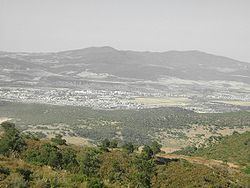Country Algeria Time zone CET (UTC+01) Districts 10 Population 482,261 (2008) Municipalities 34 | Area Code +213 (0) 37 Area 4,101 km² ISO 3166 code Algeria | |
 | ||
Guelma
Guelma Province (Arabic: ولاية قالمة) is a province (wilaya) in eastern Algeria. Its namesake is its seat and most populous municipality: Guelma.
Contents
- Guelma
- Map of Guelma Province Algeria
- History
- Demographics
- Geography
- Administrative divisions
- Notable residents
- References
Map of Guelma Province, Algeria
History
Its civilians suffered heavy casualties during the 1945 Sétif massacre by the French Army. The province itself was established on 1974. Before that, it was part of Annaba Province. In 1983, the province lost its south-eastern half in favor of the creation of Souk Ahras Province.
Demographics
It has 429,998 inhabitants as of the 1998 census, one of the lower populations in the country, which gives it 39 seats in the APW, the province's assembly. The population density is 105 inhabitants per square kilometre (272/sq mi). Of them, 54,4% live in urban areas and 87% have access to safe drinking water, lower than the national average of 89%. [1]. Of the active population of the province, 23,3% work in agriculture, 17,9% in constructions, 9,9% in industry, and 48,9% in the services sector. 21,1% of the population is unemployed.[2]
Geography
The territory of the province (4,101 km2 (1,583 sq mi) is mainly composed of arable lands (about 49%) or 1,890 km2 (730 sq mi) of which about 100 km2 (39 sq mi) is irrigated, and the rest is rainfed. In the area surrounding Guelma, around 130 km2 (50 sq mi) is irrigable, 110 km2 (42 sq mi) in the area between Oued Zenati and Tamlouka, and 20 km2 (8 sq mi) around Bouchegouf. Forests cover about 31% of the total area, which equals 0.9 km2 (0 sq mi) composed mainly of Aleppo Pine, Algerian Oak and Cork Oak. Areas dedicated for future industrial development, called activity zones in Algeria cover 2 km2 (1 sq mi). [3]
Administrative divisions
The province is divided into 10 districts (daïras), which are further divided into 34 communes or municipalities.
